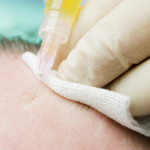PRP Platelet Rich Plasma for Hair Loss
Could it be money down the drain?
 Another day, another miracle cure! One of the latest granules of hope to come out of the scientific community is platelet rich plasma or PRP, for hair loss. It sounds very sci-fi and very promising and many have jumped on the bandwagon. To save you from another potentially money wasting fate, we have done all the research for you on PRP – what it is and how it works.
Another day, another miracle cure! One of the latest granules of hope to come out of the scientific community is platelet rich plasma or PRP, for hair loss. It sounds very sci-fi and very promising and many have jumped on the bandwagon. To save you from another potentially money wasting fate, we have done all the research for you on PRP – what it is and how it works.
What is it?
If you remember back to biology at school you’ll probably remember that blood is made up of plasma, red blood cells, white blood cells and platelets. Whilst you probably recall platelets as being responsible for clotting, what you may not know is that they also contain hundreds of proteins called ‘growth factors’. Growth factors are capable of stimulating cellular growth, proliferation, healing, and cellular differentiation (sounds promising for hair regrowth, doesn’t it?). Patients undergoing PRP have their platelets increased to roughly five times the typical baseline after undergoing a couple of harvests.
The theory behind this process is that the more platelets in the blood, the more growth factors in the blood and the more growth factors in the blood, the more cellular activity and the more cellular activity, the more hair will grow! Simple, right? Well…
Does PRP Regrow Hair?
First, let’s get one thing straight. NOTHING can regrow hair where there is no hair. The only way you can have hair again where there is no hair is to take active hair follicles from somewhere else on the body or scalp and transplant it to somewhere where there is no hair. This is why hair transplants are widely used to increase the amount of hair on the head.
The best PRP can do is to thicken up existing hair. So when PRP treatment experts say it can regrow hair what they actually mean is, it can make hair that is already there and growing finely, into hair that may be in better health and therefore may grow stronger and thicker.
There have been a few scientific studies on the effectiveness of PRP treatments for hair regrowth but they have been quite basic and only utilised small sample sizes.
One very small study carried out on 5 males by the Plastic and Reconstructive Surgery Department at the University of Rome in 2014, found a mean increase in total hair density of 27.7 ( number of hairs/cm2) following PRP treatments. This increase was noted after 3 months.
Another small study with 11 participants was published in the Journal of Cutaneous and Aesthetic Surgery in 2014. In this trial there was also evidence of an increase in the density of hair with an average mean gain of 22.09 follicular units per cm2. Less than in the previous trial mentioned.
However, in this study a slowing of hair loss was also noted.
Is PRP suitable for women?
There would seem to be no reason why it wouldn’t be suitable for women, however it is worth noting that the earlier the therapy is applied, the more likely it is to be successful. As mentioned earlier, the follicles must still be active for the PRP treatment to work.
Also, bear in mind, the clinical research we were able to find has been based on extremely small and sample sizes and there were no women involved in these studies.
A word of caution:
PRP treatments increase the growth of cells which it comes into contact with. This means that if there are any skin cancer cells in the vicinity, these too could be affected in a way which could make them also grow faster.
How does PRP Work ?
The PRP treatment involves having blood taken (usually from your arm), which is then put into a machine that separates out the platelets. These platelets are then injected via mesotherapy , which consists of multiple tiny injections, into the area of the scalp where thicker hair is desired.
treatment involves having blood taken (usually from your arm), which is then put into a machine that separates out the platelets. These platelets are then injected via mesotherapy , which consists of multiple tiny injections, into the area of the scalp where thicker hair is desired.
This is repeated in 3-4 treatments over 5-6 weeks. Each treatment takes up to about 90 minutes. If there are signs of good results in a given subject, then the treatment will need to be repeated every 3-6 months for the treatment to continue deriving a benefit.
To be effective, PRP treatments for hair loss must be ongoing. Once the treatment stops, the decline in hair thickness will pick up where it left off.
Over time, the hair around the treated area may also become sparse and new areas may need treatment. Alternatively, once hair loss, particularly in males, has advanced to a certain level, PRP treatments may need to cease to avoid an uneven result.
PRP has been used in various applications since the 1970s including cardiology, sports medicine, cosmetic surgery and pain management but has only recently begun to be associated with hair regrowth. Though plenty of companies suggest that they have had great success with PRP for hair regrowth, there is a lack of scientific evidence with the exception of the two very small studies we have mentioned here.
So while there are some positive indications that PRP could be useful in the treatment of hair loss, it is worth remembering that it is a fairly new application of the therapy and while it can help in some cases, it is not going to be suitable for everyone. And above all it will not regrow hair where there is no hair.





